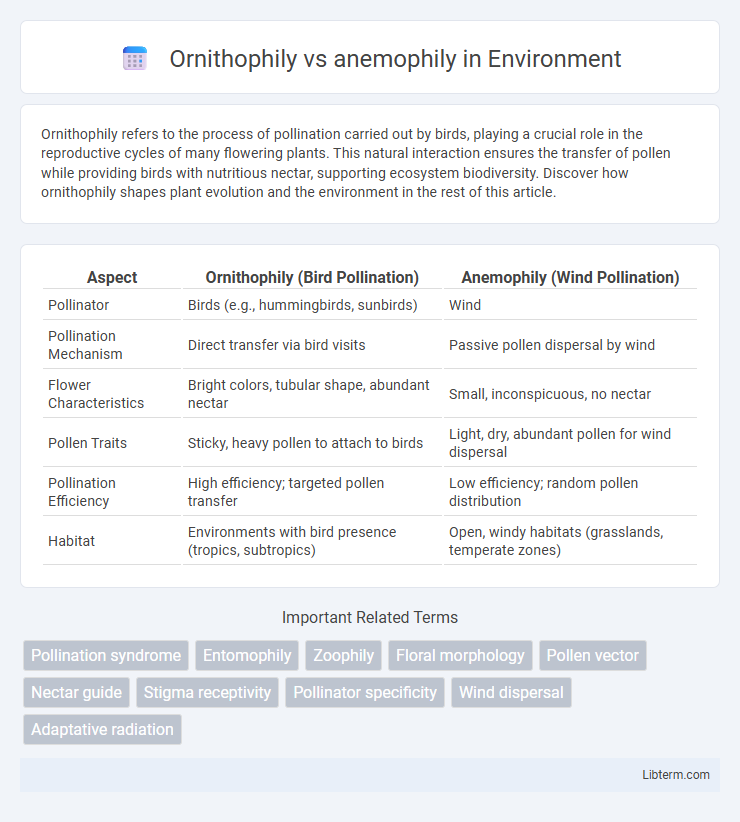Ornithophily refers to the process of pollination carried out by birds, playing a crucial role in the reproductive cycles of many flowering plants. This natural interaction ensures the transfer of pollen while providing birds with nutritious nectar, supporting ecosystem biodiversity. Discover how ornithophily shapes plant evolution and the environment in the rest of this article.
Table of Comparison
| Aspect | Ornithophily (Bird Pollination) | Anemophily (Wind Pollination) |
|---|---|---|
| Pollinator | Birds (e.g., hummingbirds, sunbirds) | Wind |
| Pollination Mechanism | Direct transfer via bird visits | Passive pollen dispersal by wind |
| Flower Characteristics | Bright colors, tubular shape, abundant nectar | Small, inconspicuous, no nectar |
| Pollen Traits | Sticky, heavy pollen to attach to birds | Light, dry, abundant pollen for wind dispersal |
| Pollination Efficiency | High efficiency; targeted pollen transfer | Low efficiency; random pollen distribution |
| Habitat | Environments with bird presence (tropics, subtropics) | Open, windy habitats (grasslands, temperate zones) |
Introduction to Ornithophily and Anemophily
Ornithophily refers to pollination by birds, where flowers exhibit bright colors, sturdy structures, and abundant nectar to attract avian pollinators like hummingbirds. Anemophily involves wind pollination, characterized by small, inconspicuous flowers that produce large quantities of lightweight pollen dispersed by air currents. These two distinct pollination mechanisms reflect adaptations to animal and abiotic vectors, optimizing reproductive success in diverse ecological niches.
Defining Ornithophily: Bird Pollination Basics
Ornithophily refers to pollination facilitated by birds, primarily involving species with brightly colored, tubular flowers that produce abundant nectar to attract avian pollinators. This pollination strategy contrasts with anemophily, where wind disperses pollen, typically featuring small, inconspicuous flowers with lightweight pollen grains adapted for airborne transport. Bird-pollinated plants often exhibit coevolutionary traits such as robust structures and extended floral tubes, optimizing nectar accessibility and pollen transfer by specific bird species like hummingbirds and sunbirds.
Understanding Anemophily: Wind Pollination Explained
Anemophily, or wind pollination, relies on the dispersal of lightweight, non-sticky pollen grains carried by air currents to fertilize plants, contrasting with ornithophily which involves bird pollinators. Plants adapted to anemophily typically produce large quantities of pollen due to the inefficiency of wind dispersal and possess exposed stamens and feathery stigmas to maximize pollen capture. This pollination strategy is common in grasses, conifers, and many deciduous trees, enabling reproduction without the need for animal vectors.
Key Differences Between Ornithophily and Anemophily
Ornithophily refers to pollination by birds, characterized by flowers that are brightly colored, often red or orange, with tubular shapes and abundant nectar to attract avian pollinators. Anemophily involves wind pollination, with flowers typically small, inconspicuous, lacking nectar or fragrance, and producing large quantities of lightweight pollen grains adapted for dispersal by air currents. The key differences lie in floral morphology, pollination vectors, and pollen characteristics, with ornithophilous plants relying on animals for targeted pollen transfer, while anemophilous plants depend on passive wind dispersal.
Adaptations in Bird-Pollinated Plants
Bird-pollinated plants exhibit specialized adaptations such as brightly colored, usually red or orange, tubular flowers that accommodate the long beaks of birds for effective nectar access. These plants often produce large quantities of dilute nectar to meet the high energy needs of avian pollinators and have sturdy floral structures to withstand bird visits. Unlike anemophilous species that rely on wind for pollen dispersal and typically have inconspicuous flowers with lightweight pollen, ornithophily enhances targeted pollination through visual and structural adaptations tailored to birds.
Morphological Traits of Wind-Pollinated Plants
Wind-pollinated plants exhibit morphological traits such as small, inconspicuous flowers lacking bright colors and nectar, which reduce energy expenditure on attracting pollinators. They possess large, feathery stigmas that increase surface area for efficient capture of airborne pollen and produce copious amounts of lightweight, smooth pollen grains adapted for wind dispersal. Stalky or dangling inflorescences promote pollen release and maximize exposure to wind currents, enhancing pollination success in anemophilous species.
Ecological Significance of Ornithophily
Ornithophily, or bird pollination, plays a crucial ecological role in maintaining biodiversity by facilitating the reproduction of numerous flowering plants, especially in regions where insect pollinators are scarce. Birds such as hummingbirds, sunbirds, and honeyeaters transfer pollen efficiently between flowers, promoting genetic diversity and plant adaptation. This mutualistic relationship supports entire ecosystems by ensuring the survival of plant species that provide food and habitat for various organisms.
Environmental Factors Favoring Anemophily
Environmental factors favoring anemophily include open, windy habitats where wind can efficiently disperse pollen grains over long distances, such as grasslands and temperate forests. Plants adapted to anemophily often produce large quantities of lightweight, non-sticky pollen to maximize the chances of successful wind pollination. In contrast to ornithophily, anemophilous species thrive in environments with low pollinator density or seasonal fluctuations in bird activity.
Pollination Efficiency: Bird vs. Wind
Ornithophily, or bird pollination, exhibits high pollination efficiency due to targeted pollen transfer by bird species such as hummingbirds and sunbirds, which actively seek nectar and facilitate cross-pollination. In contrast, anemophily, or wind pollination, is less efficient since pollen is dispersed randomly and requires abundant production to ensure fertilization, characteristic of plants like grasses and conifers. Bird pollination typically results in higher fruit set rates and genetic diversity due to precise pollen placement, whereas wind pollination depends on environmental factors like wind speed and direction for successful pollination.
Evolutionary Perspectives and Future Trends
Ornithophily, the adaptation of flowers for bird pollination, exhibits co-evolutionary traits such as vibrant colors and nectar production to attract avian species, contrasting with anemophily's reliance on wind dispersal featuring lightweight pollen and reduced floral structures. Evolutionary pressures have shaped ornithophilous plants towards specialized mutualisms, while anemophilous plants maintain broader reproductive strategies for diverse environments. Future trends in climate change may shift pollinator populations, potentially increasing the evolutionary importance of anemophily in open habitats and driving further diversification in bird-pollinated flora as ecosystems adapt.
Ornithophily Infographic

 libterm.com
libterm.com